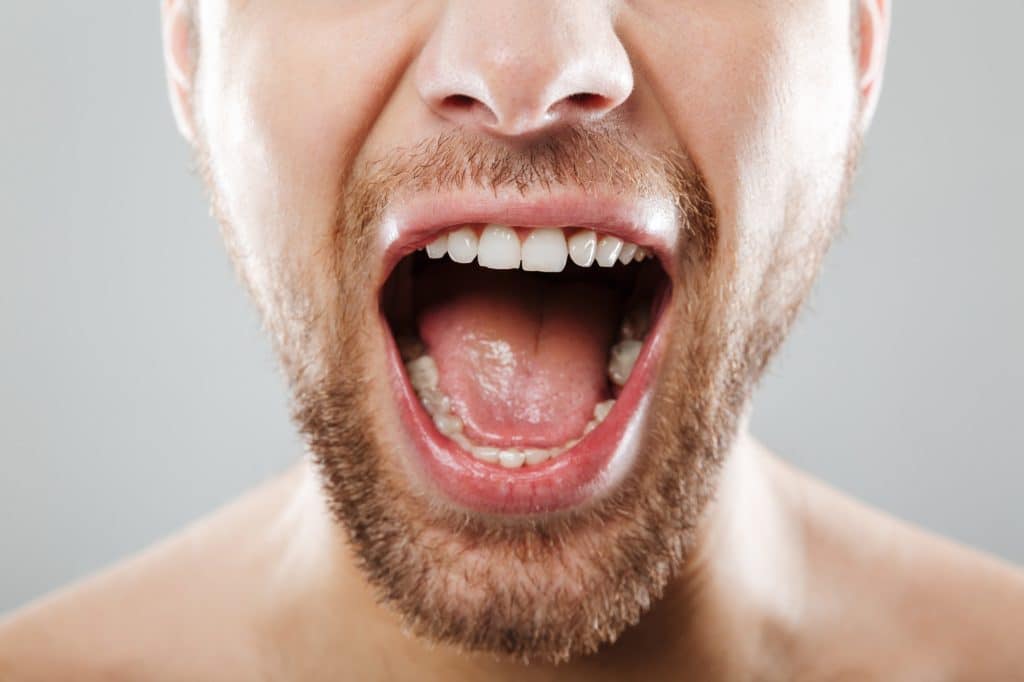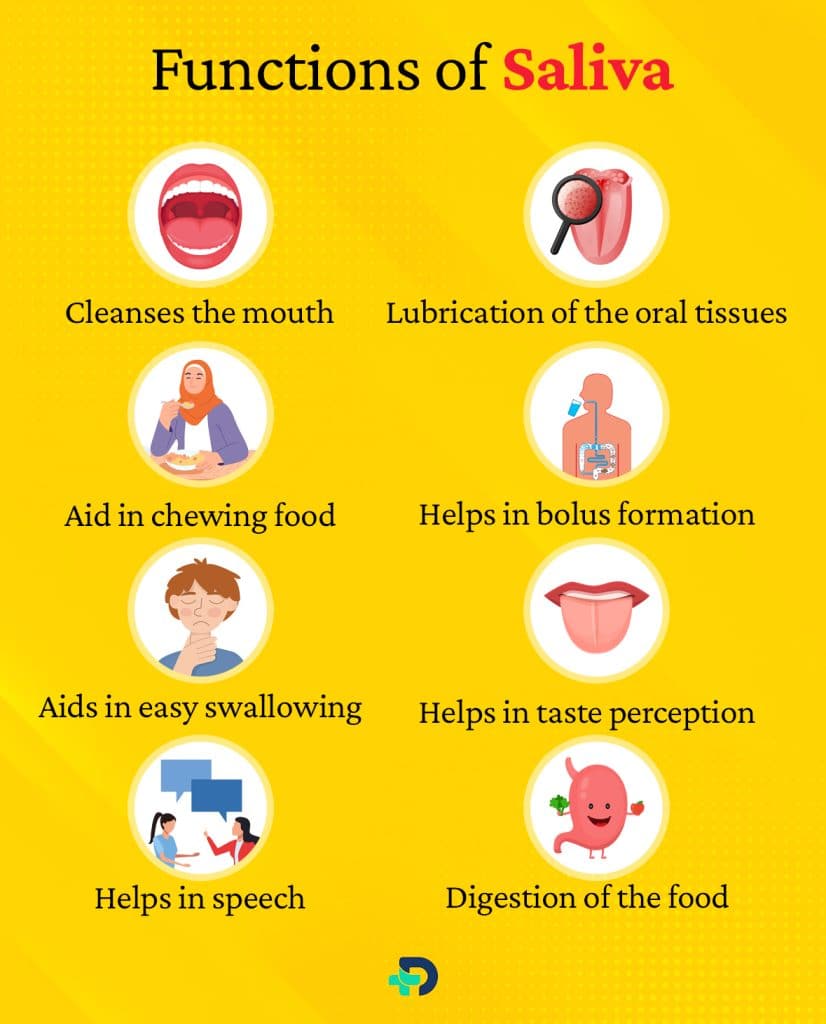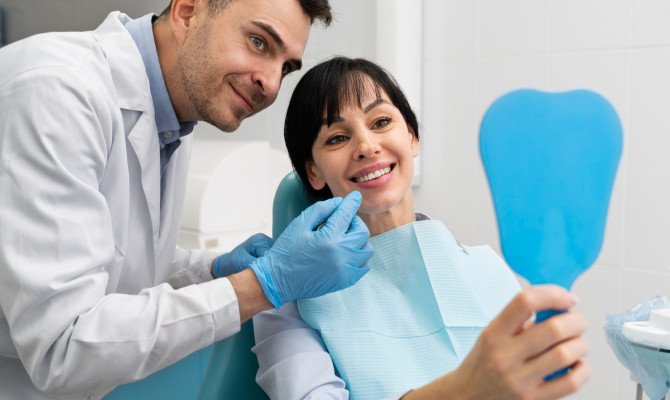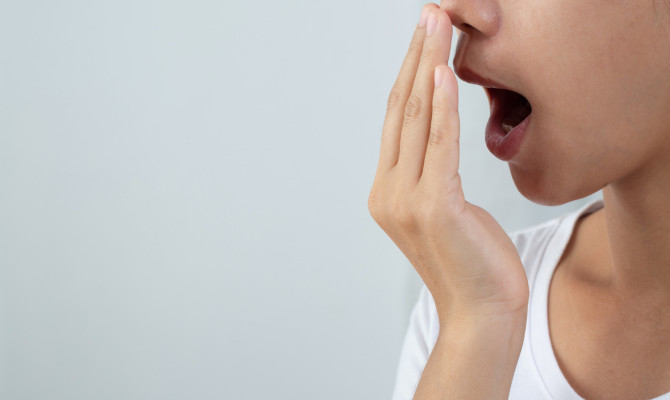Saliva : An Amazing Fluid of the Body

- Saliva
- 17 Aug 2023
Overview
What is Saliva?
Saliva is an amazing body fluid that frequently goes unseen yet is extremely important to our health and well-being. It is created by the body every day, 24 hours a day. Saliva is more than mouth lubrication because it contains a complex blend comprising water, proteins, enzymes, and electrolytes. It performs several crucial tasks for healthy digestion and teeth and even preventing illness.
This article discusses its production, composition, pH, many functions, and the conditions where there is excess or too little salivary production.

Key Facts
- There are six main salivary glands in the human body. Of these, two are submandibular, two are sublingual, and two are parotid glands.
- The submandibular and sublingual glands are placed on the floor of the mouth, while the parotid glands are situated opposite the upper first molars.1Overview| Researched based study from Thejpd.org
- Our mouths include several minor salivary glands primarily located in the lower lip, tongue, palate, cheeks, and throat.
- In healthy individuals, the daily flow of saliva ranges between 1 and 1.5 Liters.2Facts| Researched based study from Nlm.nih.gov
Composition
What is Saliva made of?
Saliva is primarily composed of :
- Water – 99% (2)
- Inorganic and organic substance – 1 %
Inorganic constituents
- Sodium chloride
- Potassium chloride
- Sodium bicarbonate
- Disodium
- Hydrogen phosphate ion
- Calcium carbonate
- Potassium thiocyanate
Organic constituents
- Protein – Mucins, amylases, defensins, cystatins, histatins, proline-rich proteins, statherin, lactoperoxidase, lysozyme, lactoferrin, and immunoglobulins
- Anti-microbial compounds – Lymphocytes
- Enzymes – Amylase and lipase
- Epithelial cells 3Composition| Researched based study from Nlm.nih.gov
Together, these elements result in a fluid that is dynamic and serves a variety of purposes.
Production of saliva
- All three pairs of main salivary glands and several minor salivary glands produce saliva.
- The submandibular, parotid, and sublingual salivary glands account for 90% of the total saliva secretions, with minor salivary glands making up the remaining 10%.2Production| Researched based study from Nlm.nih.gov
- The rate of saliva production is not the same throughout the day; it rises during eating, chewing, or other stimulating activities and falls during sleep.
pH
What is the pH of Saliva?
- The pH of saliva typically ranges from 6.2 to 7.6, with 6.7 being the average.4pH| Researched based study from Nlm.nih.gov
- With age, the saliva of an individual becomes more acidic.
- Saliva’s pH level is altered by food and beverages. For instance, when people eat carbohydrates, bacteria in their mouth convert them into lactic, butyric, and aspartic acids, and the saliva’s pH decreases.
Functions

Functions of Saliva
Saliva is important for several important functions :
- Cleanses the mouth
- Lubrication of the oral tissues 5Functions| Researched based study from Mpdi.com
- Aids in chewing food
- Digestion of the food
- It helps in bolus formation
- Aids in easy swallowing
- Helps in speech
- Helps in taste perception
- Dilutes debris
- Is Anti-microbial
- Re-mineralizes teeth
- Maintains oral pH
- Maintains mucosal integrity
Cleanses the mouth
- Continuous secretion of saliva in our mouth ensures all the structures, including teeth, tongue, gums, palate, and cheeks, are all appropriately cleansed.
Lubrication of the oral tissues
- Saliva forms a protective coating over all the oral structures preventing friction between them, without which oral tissues may feel uncomfortable and sticky.
Aid in chewing food
- The size of the food particles decreases during chewing.
- Saliva moistens the food particles, and salivary mucins bind masticated food into a cohesive bolus that can be readily swallowed.6Functions| Researched based study from Nlm.nih.gov
Helps in bolus formation
- When food is combined with saliva in the mouth, it helps the combination form a ball called the bolus, which is swallowed later.
Aids in easy swallowing
- Saliva lubricates the mouth and throat, starts the breakdown of food, and facilitates swallowing.
Digestion of the food
- Saliva contains a variety of digestive enzymes that aid in the breakdown of food particles in the mouth.
- Amylase, an enzyme, breaks down complicated carbohydrates into sugars that the body can absorb more easily.
- Lingual lipase is an enzyme found in saliva that breaks down lipids.7Functions| Researched based study from Altonmemorialhospital.org
Helps in speech
- The production of saliva lubricates the tissues in the mouth, improving the smoothness of speech and pronunciation.
Helps in taste perception
- Saliva is the solvent for flavor compounds when we eat, dissolving and transporting them to the taste sensor locations.8Functions| Researched based study from Nlm.nih.gov
Dilutes debris
- It continuously aids in diluting the bacteria and food particles in the mouth, rinsing them all away.
Works as anti-microbial
- Saliva is essential for the defense against microbes because it contains many anti-microbial substances, including lysozymes, hydrogen peroxide, and lactoferrin.9Functions| Researched based study from Nlm.nih.gov
Re-mineralizes teeth
- When we consume acidic beverages, the pH of our saliva can go below 5.5.
- At acidic pH, our mouth’s acids tear down teeth enamel by demineralization.
- Saliva can help remineralize the areas of demineralized enamel surfaces over the teeth by its ions, such as fluoride, calcium, and phosphate content.10Functions| Researched based study from Nlm.nih.gov
Maintains oral pH
- Our mouth needs a pH balance, much like the rest of our body.
- Saliva helps keep the mouth’s pH close to neutral (6.7 – 7.3) by two methods.
- First, it gets rid of acids from bacteria by digesting the carbohydrates in our mouth.
- Second, saliva’s buffering properties help to balance acidity from foods, drinks, and bacterial activity.
Maintains mucosal integrity
- Lubricating the mouth and its structures maintains oral mucosal integrity by preventing injury from friction.
Saliva as a diagnostic tool
- Researchers have found that saliva contains a variety of biomarkers that can provide information about a person’s health and detect the presence of certain diseases, such as viral infections, autoimmune diseases, and oral cancers.
- Saliva collection is non-invasive, making it a desirable substitute for invasive blood testing, and continuing research in this area shows significant potential for early detection of illnesses.
Hypersalivation
Hypersalivation
- It is a condition in which saliva production is excessive, and it could be temporary or long-lasting, depending on the underlying reason.
- Cavities, infections, pregnancy, poisoning, using certain drugs, and stomach reflux can all cause sudden or temporary production of excess saliva.
- A persistent medical condition that impairs muscular control and can lead to constant hypersalivation, including an enlarged tongue, stroke, facial nerve paralysis, intellectual disability, Parkinson’s disease, and many more.11Hypersalivation| Researched based study from Nationwidechildrens.org
- The course of treatment for excessive salivation depends on the underlying cause. Thus, those who are affected should see a doctor.
Hyposalivation
Hyposalivation
- It is a condition when a person does not produce enough saliva to moisten their mouth, resulting in a dry mouth that can impact their oral and general health.
- Dehydration, therapeutic drugs for high blood pressure, depression, the common cold, etc., or neck and head radiotherapy, autoimmune diseases including Sjogren’s syndrome, rheumatoid arthritis, diabetes, or aging-related reduction in salivary gland function are the leading causes of this.12Hyposalivation| Researched based study from For.org
- Using recreational drugs, alcohol, or tobacco might also result in less saliva.
- The treatment for dry mouth varies according to the cause, and people with this condition should consult a doctor and get it treated to prevent various health problems.
Outlook
The Outlook
Saliva is a versatile and complex fluid that plays several vital roles in our bodies yet is frequently taken for granted. Saliva is essential to maintaining our general health and well-being since it helps with digestion, lubrication, pathogen defense, and wound healing. Additionally, new opportunities for non-invasive illness detection and monitoring are made possible by current studies into the diagnostic potential of saliva. Saliva has a variety of functions, and recognizing this can help us prioritize oral health and use its diagnostic capabilities to improve healthcare procedures in the future.
Any feedback on this article?
 This Articles content was accurate
This Articles content was accurate Very Informative Article
Very Informative Article I have a question or a comment
I have a question or a comment
 This article contains inaccurate content
This article contains inaccurate content This article was not helpful
This article was not helpful I have a question or a comment
I have a question or a comment
We appreciate your helpful feedback!
Checkout our social pages
References
-
The Journal of Prosthetic Dentistry
A review of saliva: Normal composition, flow, and function | Overview
-
National Library of Medicine
Saliva between normal and pathological. Important factors in determining systemic and oral health | Overview
-
National Library of Medicine
Comparative Human Salivary and Plasma Proteomes | Composition
-
National Library of Medicine
Salivary pH: A diagnostic biomarker | pH
-
MPDI
The New Era of Salivaomics in Dentistry: Frontiers and Facts in the Early Diagnosis and Prevention of Oral Diseases and Cancer | Functions
-
National Library of Medicine
MASTICATION AND SWALLOWING: INFLUENCE OF FLUID ADDITION TO FOODS | Functions
-
Alton Memorial Hospital
The Digestive Process: Digestion Begins in the Mouth | Functions
-
National Library of Medicine
Role of saliva in the maintenance of taste sensitivity | Functions
-
National Library of Medicine
The power of saliva: Antimicrobial and beyond | Functions
-
National Library of Medicine
The role of salivary contents and modern technologies in the remineralization of dental enamel: a narrative review | Functions
-
Nationwide Children’s Hospital
Sialorrhea (Excessive Drooling) | Hypersalivation
-
Foundation for Oral Rehabilitation
Hyposalivation and Xerostomia | Hyposalivation



































